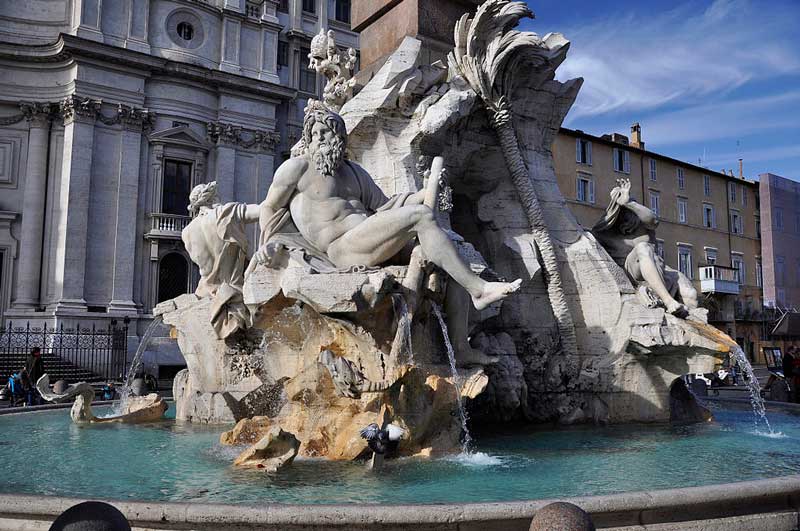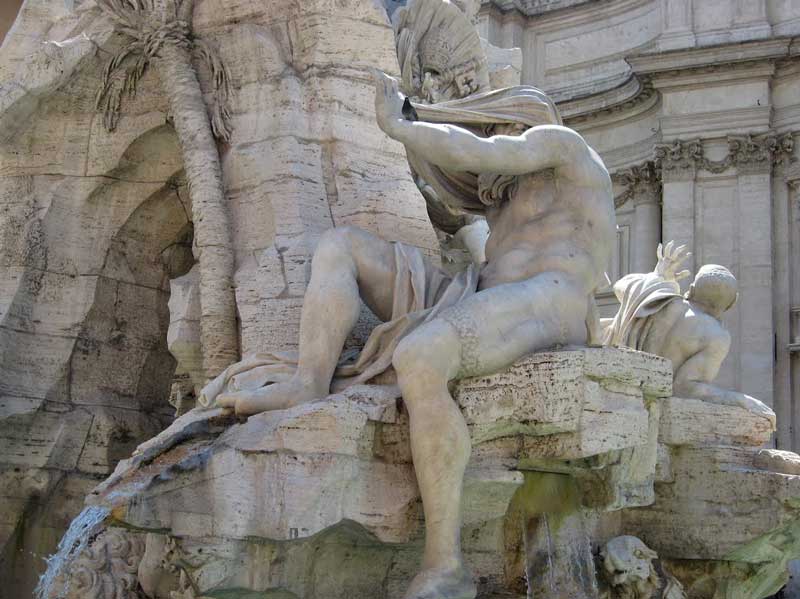
Located in the Piazza Navona in Rome, the Fountain of the Four Rivers, alias Fontana dei Quattro Fiumi, can easily be described as a kind of theatre in the round with its charming sculptural details, majestic presence and the dramatically spurting water. Considered by many as the epitome of Baroque architecture, it deeply influenced the shape of Italian fountains for the entire century to come. Long before the days of indoor plumbing, the fountain was an important source of potable water for the locals, but more importantly, it was an extremely imposing monument to magnify the power and the glory of the pope and his family.
Gian Lorenzo Bernini, one of the most celebrated sculptors in history, designed the colossal fountain in 1651. However, initially Pope Innocent X intended to award the project to Francesco Borromini instead of Bernini, who had received much support from the previous pope Urban VIII. He gave Bernini over 30 commissions during his papacy and at his instance Bernini created the scenographic arrangement of St Peter’s Square, surrounded by its massive quadruple colonnade. In 1638, he began one of the most ambitious architectural projects of his career, to design and construct the massive twin bell towers atop St. Peter’s basilica at the Vatican. Unfortunately, due to some unknown reasons the project failed spectacularly, which tarnished his reputation. However, when Pope Innocent X awarded the construction of the new fountain to Borromini, Bernini created a model of the fountain on his own and through his intimate sources persuaded Pope Innocent X to have a look at his design. It pleased the pope and he assigned the project to Bernini instead of Borromini.

Before the creation of the Fountain of the Four Rivers, Bernini had successfully constructed the Fountain of Triton in Piazza Barberini, the Fountain of the Moor at the southern end of Piazza Navona and the statue of Neptune and the Triton for the Villa Peretti Montalto, which now resides at the Victoria and Albert Museum in London. With the creation of the Fountain of the Four Rivers, Bernini once again constructed a monument without precedent.

The Fountain of the Four Rivers seems to be the stage of a round theater, where the leading actor is the movement and the sound of water splashing over and cascading down a mountain of travertine marble. The fountain is built around a slender obelisk, surmounted by a dove with an olive twig in its beak, representing peace, the Holy Spirit and the symbol of the papal family. The 52 feet (16 m) tall obelisk is a Roman version of an Egyptian obelisk, built by the order of the Roman Emperor Domitianus and shifted to the site of the fountain from its original location in the Circus of Maxentius.
The colossal marble statues of the fountain rest on a large rock that rises from a circular basin and are part of a dramatic scene decorated with flowers and animals. The seven animals, which are present in the scene and positioned around the fountain, include a horse, a sea monster, a serpent, a dolphin, a crocodile, a lion and a dragon.

It is considered that the gigantic marble figures represent the four major rivers of the four continents, namely the Ganges in Asia, the Nile in Africa, the Danube in Europe and the Río de la Plata in America. The representative statues of the Rivers were sculpted by Bernini's students, while he himself took care of the decorative elements, like the lion, sea creature and the palm tree.


The Danube, created by Antonio Raggi, touches the Papal coat of arms, since it is the largest river closer to Rome. To his left sits an allegorical figure of the Ganges, created by Claude Poussin, who carries a long oar, representing the river's navigability. The figure of the Nile was created by Giacomo Antonio Fancelli and the head of the figure is symbolically draped with a loose piece of cloth, since at that time the source of the river was unknown.
The last allegorical figure in the scene, the figure of the Rio de la Plata of the American continent, created by Francesco Baratta, is sitting on a heap of coins, the symbol of wealth that America might offer to Europe. The figure seems to be scared by a snake, indicating rich men's apprehension about the safety of their money.



It is believed that the construction of the fountain was met with disapproval by the people of Rome, since it was indirectly financed by the public money collected by imposing unpopular taxes during the famine of 1646-1648, on items of basic needs, like bread, meat and salt. Nevertheless, the wonderful masterpiece was officially unveiled on 12 June 1651, which till today continues to amaze and entertain the visitors from all over the globe. During the Second World War, some American soldiers cut off the fingers of the statues, which were replaced shortly after the war.